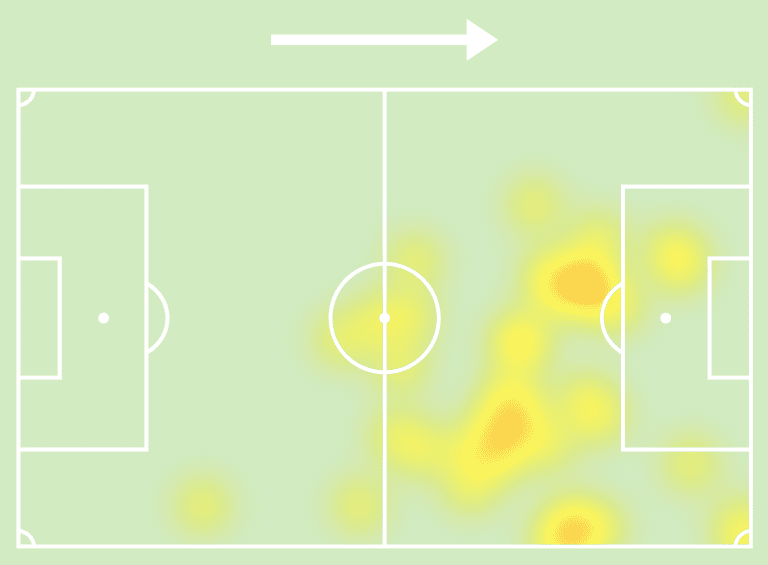I, like so many of you, still haven’t quite come down from the incredible high that was Friday night.
As someone who has watched an absurd number of MLS games over the last several years, the impact Lionel Messi and Sergio Busquets made in their Inter Miami CF debuts was unique in every possible way. Coming off the bench in the 54th minute in an eventual 2-1 win over Cruz Azul in Leagues Cup, both players transformed Miami’s structure and elevated their attacking play in the blink of an eye.
That improvement isn’t a surprise, given Messi and Busquets' status as two of the greatest soccer players of all time. But how exactly did they change Inter Miami? Where did manager Tata Martino position his two new stars? And how did Messi and Busquets work together to create mayhem for the opposing defense?
Let’s dive into the first taste of a new era.
Less than 10 minutes into the second half of Inter Miami’s match against Cruz Azul, Messi made his way onto the field at DRV PNK Stadium for the very first time. After hugging 18-year-old Benjamin Cremaschi, high-fiving multiple teammates, clasping hands with the referee and receiving the captain’s armband from DeAndre Yedlin, Messi finally made it over to his designated part of the field: the right halfspace.
Sure, he was nominally playing as a right winger in possession. But Messi wasn’t quite on the wing, nor was he constantly in the middle of the field.
No, Martino used Messi in the right halfspace in his Miami debut, giving the Argentine legend as much freedom as possible to flex inside or outside at a moment’s notice. You can see Messi’s attacking heatmap down below, courtesy of Sofascore, with touches sprinkled mostly across the right half of the field.

Messi has enjoyed a ton of success throughout his career in that right halfspace role. He’s Messi for crying out loud, the one controlling the most skillful left foot in history.
He can get on the ball and cut in on his left, blowing by defenders with quick touches and his low center of gravity. Or, the No. 10 can drift into the middle, receive a pass there, and then dart forward through the heart of the opposing team's defensive shape – which is exactly what happened on his first-ever touch for Miami. After dropping deep, Messi received a ball from Yedlin and drove at the Cruz Azul defense, combining his way down the entire remaining length of the field via quick one-twos with his teammates.
We shouldn’t be surprised to see Messi play a dedicated central role at times moving forward. Still, the early returns on his work shading towards the right side were familiar, which is to say they were exceedingly positive. With him and Busquets on the field, Miami could suddenly progress the ball upfield and play through the lines with ease (more on that later). Nearly all of Messi’s 36 touches put Miami into better attacking positions, and his last one turned his already-historic debut into a legendary one.
Messi did, well, Messi things in the attack for Miami. He also did Messi things in defense, which is to say he didn’t do much on that side of the ball.
Martino mostly used Messi as part of a front two in a 4-4-2 mid-block on Friday. He stayed high next to Josef Martínez, while left winger Robbie Robinson shifted back into the midfield line and right-sided No. 8 Dixon Arroyo moved out to defend as a right midfielder. The rotations were clearly pre-planned to limit Messi’s running – just hang out in the middle until we win the ball back – and to get extra numbers behind the ball.
Accommodating Messi’s defensive shortcomings is non-negotiable for his new teammates…but that doesn’t mean it’s easy.
On this play from the 79th minute, Messi is positioned so far upfield that he’s not visible in the initial picture. As the ball moves backwards, he comes into view a few yards ahead of Martínez. Without any real pressure coming from the front two, Miami’s midfield line is forced to step out of shape in an effort to slow down Cruz Azul’s attack. Ultimately, Arroyo and Yedlin end up stuck in a three-v-two on the right side and are forced to watch as their Liga MX foes break into the box.
It should be easier for Miami to absorb opposing attacks once some of their younger summer reinforcements are integrated. Even with some defensive issues, though, using Messi as part of the front two without the ball, and in the right halfspace with it, makes a ton of sense. He’ll have every chance to terrify Inter Miami’s opponents from this point forward.
So far, he’s one-for-one.
Unlike Messi, who will conceivably pop up in a number of spots in the attack this year, Sergio Busquets’ role won’t change from now until he hangs up his boots.
He’s a No. 6.
Busquets defended as part of the midfield line of four and anchored all of Miami’s possession play after coming off the bench against Cruz Azul. The Spaniard played line-breaking pass after line-breaking pass, consistently moving the ball upfield and into more dangerous areas.
Here’s a little taste of some of his finest moments, which should look familiar to folks who have watched him play for FC Barcelona or Spain at any point in the past:
The connection between Busquets and Messi was particularly strong: out of his 34 touches on Friday, 12 passes went straight to Messi. From the moment the pair stepped on the field, it was clear their years of playing together at FC Barcelona mixed with their incredibly high skill levels have created an almost telepathic connection.
This play is just one (of many) examples where Busquets receives the ball at the base of midfield, scans his surroundings and picks out Messi with a perfectly weighted line-breaker.
Those kinds of progressive passes are a welcome sight in Miami. So far this year in MLS regular-season play, Inter Miami have truly struggled to move the ball forward with any sort of precision or speed (with injuries factoring in). They’re 22nd in the league in progressive passes per 90 minutes, according to FBref, and 27th in the league in direct attacking speed, according to Opta. With Busquets involved, expect Miami to climb up the rankings in both of those statistics – and fast. After playing eight line-breaking passes in limited minutes on Friday night, just imagine the damage he’ll do to an opposing defensive shape over the course of 90 minutes.
Between Busquets’ distribution from midfield and Messi’s elite playmaking in the right halfspace, Inter Miami are a totally different team now than they were even just a few days ago. They’ll have more than a few obstacles to overcome, but the stars have clear roles and fantastic chemistry. You can’t ask for much more than that out of the gates.











